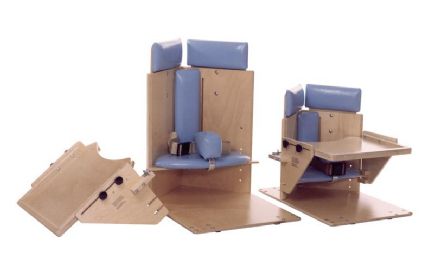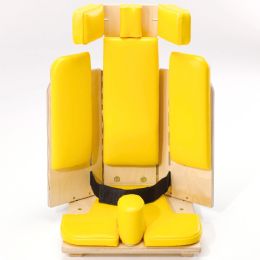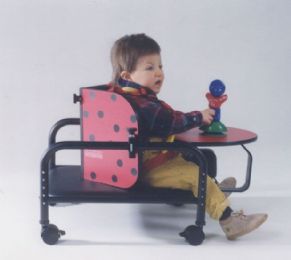


What is a Corner Chair?
A corner chair has a V-shaped backrest that provides support at the back and sides of the user, and is made specifically for users who cannot stabilize themselves against gravity. Corner chairs are perfect for children who may need head, trunk and pelvis support for attaining proper sitting alignment and posture. The corner chair will usually have a sturdy base so it can be the same height as a regular chair and be used at a table. Conversely, the base can be removed so the corner chair and child can both be placed on the floor for playing, allowing the child to interact more easily with their contemporaries at the same eye level either at a table setting, or on the floor during playtime.
How Does a Corner Chair Work?
A corner chair’s V-shape offers lateral supports for the upper trunk while simultaneously preventing shoulder and scapular retraction, and provides support for the user in shoulder girdle protraction that tends to decrease extensor spasticity in users with tone problems such as cerebral palsy. The back-and-side support of the corner chair primarily used for children with adequate head control to maintain an upright position will assist users with some upper extremity and trunk control by promoting upper extremity midline positioning. With the freedom of the hands and arms placed forward, the child is now able to use them more freely for play, exploration, visual scanning, attending to objects, speaking and eating. Young users with low trunk tone may also show improved breathing.
What are Some Benefits of Adaptive Seating?
Adaptive seating products provide skeletal stability that assist in improving postural control, helping to hold the pelvis in a neutral position, and contributing a more secure foundation for the rest of the user’s spine. This allows the child to better develop heightened functional ability, particularly with the mobility of the arms leading to self-feeding skills and proper digestion, grasping objects and interacting with other children, and allowing more freedom to visually scan the immediate area around the chair.
What is commonly observed by researchers is that users of adaptive seating devices can also experience an increase with social interaction, performance of the activities of daily living (ADL), and occupational satisfaction. A study also suggests that regular use of adaptive seating products can help prevent the deterioration of a child’s measured skill set over a five year period, showing that these devices can help ‘lock in’ the present level of existing abilities and over time, result in an overall cumulative improvement.
Corner Chair Accessories
Chair Base - A corner chair will have a wide, secure base for stability, and increase the height of the chair to be used at a table to facilitate learning or play. A corner chair raised on a base also allows knee flexion, hip flexion and thigh alignment, while it additionally reduces tightness in the hamstrings, and spasticity in pelvic and spinal alignment for the user.
The base can be removed and replaced with extended floor supports for the chair to be used as a floor sitter, allowing the users to relax and extend their legs. Because a floor is often a favored spot for children to play on, a floor sitter will allow young users to interact more easily with others during playtime, story time, or learning games while keeping the same-level eye contact with their peers.
Abductors – Corner chairs can come with abductors, which are rectangular cushions located at the front-edge of the seat between the distal femurs to ensure hip alignment. Abductors prevent users from sliding out of the chair.
Seatbelt – In conjunction with the abductor, the seatbelt will help prevent the user from pushing or sliding out of the chair.
Adjustable Tray – Helping the user gain shoulder protraction and symmetrical arm posture, a corner chair tray can also promote the use of the hands while in a sitting position. A tray can additionally be positioned to assist the user to bear weight through the elbows to facilitate hand movements.
Rehabmart is proud to offer innovative pediatric corner chairs from such renowned vendors as Innovation In Motion, R.E.A.L. Design, Otto Bock Health, Sammons Preston, Kaye Products, Inc., and Maddak.
Hulet Smith, OT
Rehabmart Co-Founder & CEO
ws